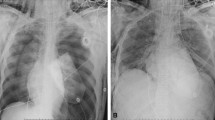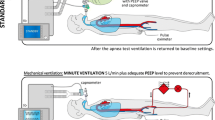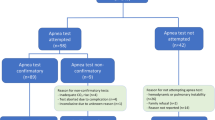Abstract
Introduction
The apnea test is a crucial component of the clinical diagnosis of brain death. Apprehension about hypoxemia, hypotension, and/or cardiac arrhythmias may sometimes lead clinicians to avoid performing or prematurely terminate the apnea test. The purpose of this study was to perform a contemporary re-evaluation of the safety of the apnea test.
Methods
We performed a detailed chart review of consecutive brain dead patients who underwent an apnea test from 2008 to 2012.
Results
Out of 63 patients, 33 were men (52.4 %). Mean age was 46.4 years. In all but four patients (93.7 %), the apnea test was performed by a neurointensivist. Infiltrates on chest radiographs were present in 34 (54 %). Seven patients (11.1 %) had chest tubes, six of which were associated with polytrauma. Echocardiograms were obtained in 47 patients (74.6 %), and 18 patients (38.3 %) had regional wall motion abnormalities (IQR 41–65 %). Fifty patients (79.4 %) were on vasopressors prior to apnea test. Median FiO2 was 0.5 (IQR 0.4–0.6), and PEEP was 5 cm H2O (IQR 5–10). After apnea test, median pO2 was 306 mmHg (IQR 121–389). Apnea test was aborted in only one patient; this patient had required FiO2 0.9–1.0 prior to the test and desaturated during the test. Mild hypoxemia occurred in three others without any consequences. Mild hypotension occurred in 11 patients (17.4 %) and was easily managed by an increase in the vasopressor infusion. There were no instances of major cardiac arrhythmias.
Conclusion
Apnea determined using the oxygenation diffusion method during brain death testing is very safe, provided appropriate prerequisites are met. We found a major decrease in the number of aborted or not attempted apnea tests compared to previous studies.
Similar content being viewed by others
Introduction
Brain death is defined as irreversible loss of all demonstrable brain function, including the brainstem [1]. Catastrophic injuries to the brain either from trauma or other causes, such as massive hemorrhage, infection, anoxia, or fulminant hepatic failure, can lead to brain death. On clinical examination, such patients will have absence of all brainstem reflexes, which include corneal, oculocephalic, gag, and cough. Pupils are fixed and dilated. There is no motor response to noxious stimulation except on occasion some reflex responses mediated by the spinal cord.
Determination of apnea using the oxygenation diffusion method is a crucial component of the clinical determination of brain death [2]. The oxygenation-diffusion technique for apnea testing involves disconnection from the ventilator and placement of an oxygen cannula into the endotracheal tube to deliver high-flow oxygen. Metabolic production of carbon dioxide continues, but because exhalation of carbon dioxide does not occur, the carbon dioxide tension in arterial blood (PaCO2) rises rapidly. Under normal physiologic circumstances, a rapid rise in PaCO2 to 60 or 20 mmHg above baseline is sufficient to cause an acidosis that is sensed by medullary chemoreceptors and stimulates respiration to maintain acid–base homeostasis. Clinically, brain-dead patients do not have intact brainstem function and do not initiate respirations despite a rise in PaCO2 that would normally be sufficient to stimulate respiratory drive.
Reported complications of the apnea test include hypotension [3], cardiac arrhythmias, pneumothorax, and hypoxemia [3–7]. Although a recent study did demonstrate safety of this procedure [8], apnea test using the oxygen diffusion technique with endotracheal catheter continues to remain a concern for many practitioners because of the fear of these complications. The aim of this study was to perform a contemporary re-evaluation of the safety of the apnea test.
Methods
As this study involved all deceased patients, IRB review was not required in accordance with the Code of Federal Regulations, 45 CFR 46 [9].
Our organ procurement organization (OPO) maintains a record of all patients who are declared brain dead. Hospital policy requires the OPO to be contacted in all cases involving severe brain injury or imminent brain death, which is typically performed by the nursing staff taking care of the patient. This ensures that all patients who may meet criteria for brain death or donation after circulatory death are evaluated.
From our OPO database, a total of 76 adults who were declared brain dead during the period of 2008–2012 were identified. We excluded a total of six patients: Three patients had highly restricted access to their medical records, and the remaining three patients had inadequate information to locate their electronic chart. Seven patients did not undergo apnea test for various reasons: Three patients had severe hemodynamic instability at baseline, one had a high cervical cord lesion from fracture of the spine making apnea test less reliable, and one had a baseline PaCO2 of 63 mmHg. In the remaining two patients, apnea test was not attempted for reasons that could not be surmised from the records.
Data on apnea test were available on the remaining 63 patients. The variables that were collected included demographic information, intensive care unit (ICU) location (neuroscience vs. non-neuroscience ICU), and cause of brain death. Chest X-rays were reviewed to identify the presence of pulmonary infiltrates, pleural effusions, chest trauma, and chest tubes. Echocardiograms were reviewed, and data on ejection fraction and regional wall motion abnormalities were collected. Information about vasopressor and inotrope infusions, arterial blood gas (ABG) results, and systolic and diastolic blood pressure recordings at the time of the apnea test was gathered. Complications that were identified included hypoxemia, hypotension, pneumothorax, cardiac arrhythmia, or any other complication that was documented in the records. Hypotension was defined as systolic blood pressure <90 mmHg or more than 50 % increase in the requirement of vasopressor infusion when the patient was already receiving vasopressor support prior to the apnea test. Desaturation was defined as drop in O2 saturation below 90 %.
At our institution, the apnea test is performed using the standard oxygen diffusion technique. Patients who meet specific prerequisites (Table 1) are pre-oxygenated with 100 % FiO2 for at least 10 min. Following a baseline ABG, the ventilator is disconnected and oxygen is delivered at 6 L/min through a cannula inside the endotracheal tube and the tip located near the carina. The patient is carefully monitored with close attention to spontaneous respiratory effort and vital signs. Approximately after 8 min, another ABG is drawn. If PaCO2 >60 mmHg or if the PaCO2 has increased >20 mmHg above the previous baseline, and there were no spontaneous respirations, the patient is declared apneic. Provided the remainder of the criteria are fulfilled (Table 1), the patient is subsequently declared clinically brain dead.
Results
Among the 63 patients included in this study, 33 were men (52.4 %) with a mean age of 46.4 ± 16.9 years. In all but four patients (93.7 %), the apnea test was performed by an experienced neurointensivist. The most common causes of brain death were intracranial hemorrhage, traumatic brain injury, and anoxic brain injury (Table 2). Most patients (n = 38, 60.3 %) were examined in the neuroscience ICU, while 25 (39.7 %) were in other ICUs.
Infiltrates on chest radiographs were present in 34 (54 %) patients, 14 (22.22 %) of which were bilateral. Seven patients (11.1 %) had chest tubes, two of whom had bilateral chest tubes. Pleural effusions were present on 12 (19.0 %) chest radiographs. Echocardiograms were obtained in 47 patients (74.6 %), of which 18 patients (38.3 %) had regional wall motion abnormalities (IQR 41–65 %). Fifty patients (79.4 %) were on vasopressors prior to the apnea test. Of them, 17 (26.9 %) were on two vasopressors and one patient was on three agents. Median systolic blood pressure was 118 mmHg (IQR 109–134), and median diastolic pressure was 73 mmHg (IQR 61–83). Median FiO2 was 0.5 (IQR 0.4–0.6), and median PEEP was 5 cm H2O (IQR 5–10). Ventilator settings prior to disconnection included positive end-expiratory pressure (PEEP) of 10 cm H2O in 13(20.63 %), 12 cmH2O in one patient, and 15 cmH2O in three. Results of ABG are shown in Table 3.
The apnea test was aborted in only one patient (1.6 %). This patient was brain dead due to aneurysmal subarachnoid hemorrhage and desaturated during the apnea test. Prior to testing, he had been diagnosed with hypoxemic respiratory failure due to aspiration pneumonia and was requiring an FiO2 between 0.9 and 1.0 and 10 cmH2O of PEEP.
Mild hypoxemia occurred in three other patients with the lowest O2 saturations documented at 79, 87, and 90 %. In the first patient, O2 saturations dropped transiently to 79 %. Apnea test did not need to be aborted, and his pO2 was 71 mmHg following the test. The second patient was placed back on the ventilator after his O2 saturations dropped to 87 %, about 4.5 min after the start of the apnea test. However, the test was conclusive as blood gas analysis showed an increase in PaCO2 by 20 mmHg at which point he was declared brain dead. The third patient had his O2 saturation drop down to 90 %. He completed the apnea test. ABG showed a PaO2 of 70 mmHg at the time his saturations were 90 %.
Mild hypotension occurred in 11 patients (17.4 %) and was easily managed by an increase in the vasopressor infusion. There were no instances of major hypotensive episodes or cardiac arrhythmias.
Complications (Table 4)
Fifty-six out of 63 patients were organ donors. The remaining seven were non-donors for the following reasons—liver cirrhosis, cultural and religious beliefs, signs of cancer, history of drug abuse, and family declining organ donation.
Discussion
In this retrospective study of 63 adult brain-dead patients, we found that apnea determination with the oxygenation-diffusion technique was very safe, provided that the standard prerequisites were met. The apnea test was aborted in only one patient (1.6 %) and was completed without clinically relevant consequences in 98.4 % of patients. There were no instances of major cardiac arrhythmias. After the start of the apnea test, we did notice a variable increase in vasopressor requirement in some patients, but there were no instances of major hypotension. Contrary to our previously reported findings [8], we did not notice an increase in rate of premature termination of apnea test among polytrauma patients.
We found important differences between this study and our previously published series [8]. First, we noted a reduction in the number of aborted apnea tests (1.6 vs. 3 %). Patients with acute neurologic catastrophes leading to brain death may have cardiopulmonary complications needing support in the form of mechanical ventilation and vasopressors or inotropes. Patients with severe traumatic brain injury who suffer from multisystem trauma may have pulmonary contusions, rib fractures, pneumo- or hemothorax, cardiac contusions, renal failure, volume overload, and sepsis. Practitioners, both neurologists and non-neurologists, at times may be apprehensive about attempting an apnea test for fear of inducing hypoxemia, hypotension, or cardiac arrhythmias. The apnea test using the standard oxygen diffusion technique necessitates removal of artificial ventilation for a period of 8–10 min, allowing rapid buildup of CO2. That lowers the pH, which is a strong stimulus for the respiratory center. Acidosis can suppress the myocardium and cause peripheral vasodilation leading to hypotension in brain-dead patients who have impaired autonomic reflexes [6, 10]. However, it is more of a problem in patients who are not adequately pre-oxygenated. Lack of adequate pre-oxygenation leads to insufficient reserves during the apnea test, and the resulting hypoxemia can cause or exacerbate hypotension and cardiac arrhythmias. In the present cohort, after adequate pre-oxygenation, median PaO2 after the apnea test was 306 mmHg (IQR 121–389). Hypoxemia was significant enough to result in premature termination of the apnea test in only one patient in this series. Thus, these results confirm that adequate pre-oxygenation is a crucial step prior to attempting apnea test to minimize cardiovascular complications.
Second, in comparison with previous series, we also found a reduction in the number of cases in which apnea test was not attempted. Only three of 70 patients (4.3 %) were deemed too unstable to undergo the apnea test, which is lower than the previous series in which the apnea test was not attempted in 7 % of patients for similar reasons [8]. The level of ventilator support needed at baseline was also variable, with some patients requiring high levels of PEEP and FiO2 to maintain satisfactory oxygenation. The decision that a patient is too unstable to tolerate an apnea test is a matter of clinical judgment that varies among different practitioners. At out institution, overtime, we have noted increasing involvement of neurointensivists in performing the apnea test, which may be one reason to explain the decline in the frequency of apnea test avoidance. Our data thus suggest that the rate of successfully completed apnea tests increases when experienced practitioners are in charge of their performance.
Tension pneumothorax is a rare complication of the apnea test using the oxygen diffusion method. It has been attributed to obstruction of the airway with the O2 cannula with resultant air trapping [4]. In addition, pneumomediastinum and pneumoperitoneum have also been reported due to airway perforation with the supplemental oxygen cannula [5]. In our series, using a small and soft cannula for endotracheal O2 insufflation, there were no instances of pneumothorax. Furthermore, apnea tests could be safely completed in patients with high oxygenation requirements. Apnea tests were also safe among patients receiving one or more vasopressors and those with evidence of myocardial dysfunction.
In conclusion, apnea test using the oxygen diffusion technique is a safe procedure provided the prerequisites are met. High oxygen requirement and vasopressor support should not be considered contraindications for apnea test in the majority of cases. The rate of aborted apnea tests can be reduced very substantially when these tests are performed under the supervision of experienced practitioners.
References
Practice parameters for determining brain death in adults (summary statement). The quality standards subcommittee of the American Academy of Neurology. Neurology. 1995;45(5):1012–4.
Wijdicks EF, et al. Evidence-based guideline update: determining brain death in adults: report of the quality standards subcommittee of the American Academy of Neurology. Neurology. 2010;74(23):1911–8.
Jeret JS, Benjamin JL. Risk of hypotension during apnea testing. Arch Neurol. 1994;51(8198471):595–9.
Bar-Joseph G, Bar-Lavie Y, Zonis Z. Tension pneumothorax during apnea testing for the determination of brain death. Anesthesiology. 1998;89(9822015):1250–1.
Burns JD, Russell JA. Tension pneumothorax complicating apnea testing during brain death evaluation. J Clin Neurosci Off J Neurosurg Soc Australas. 2008;15(5):580–2.
Goudreau JL, Wijdicks EF, Emery SF. Complications during apnea testing in the determination of brain death: predisposing factors. Neurology. 2000;55(7):1045–8.
Saposnik G, et al. Problems associated with the apnea test in the diagnosis of brain death. Neurol India. 2004;52(15472423):342–5.
Wijdicks EFM, et al. Pronouncing brain death: contemporary practice and safety of the apnea test. Neurology. 2008;71(18852438):1240–4.
Yee AH, et al. Predictors of apnea test failure during brain death determination. Neurocrit Care. 2010;12(20217276):352–5.
Author information
Authors and Affiliations
Corresponding author
Rights and permissions
About this article
Cite this article
Datar, S., Fugate, J., Rabinstein, A. et al. Completing the Apnea Test: Decline in Complications. Neurocrit Care 21, 392–396 (2014). https://doi.org/10.1007/s12028-014-9958-y
Published:
Issue Date:
DOI: https://doi.org/10.1007/s12028-014-9958-y




